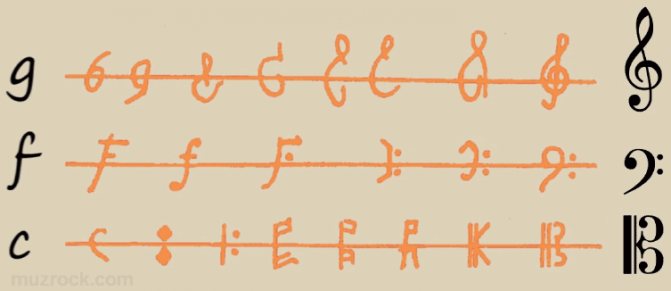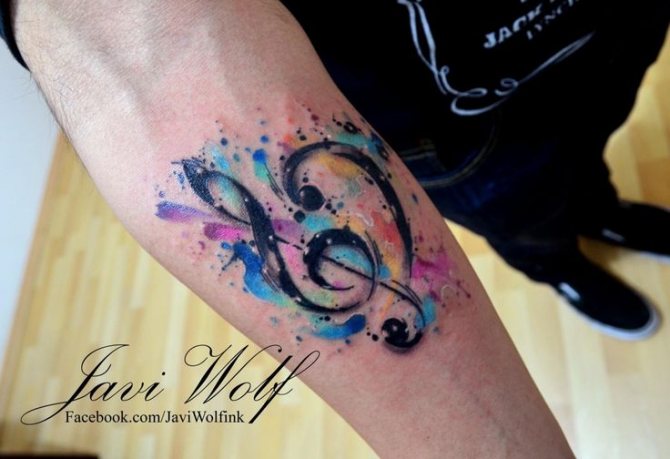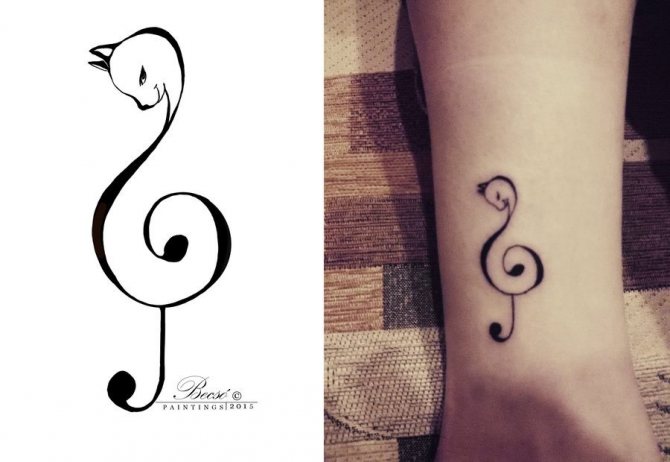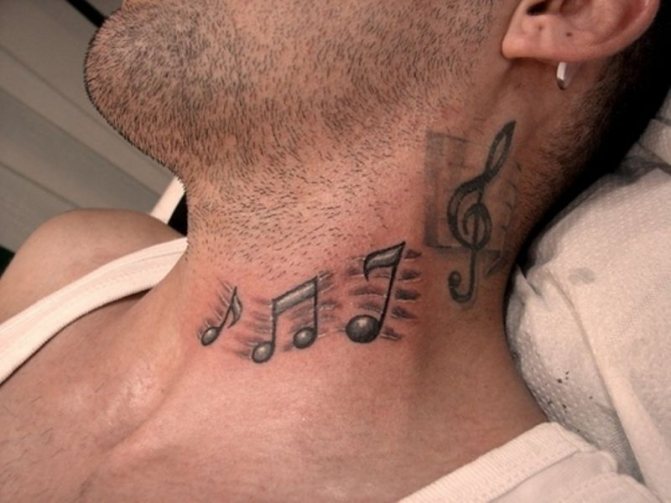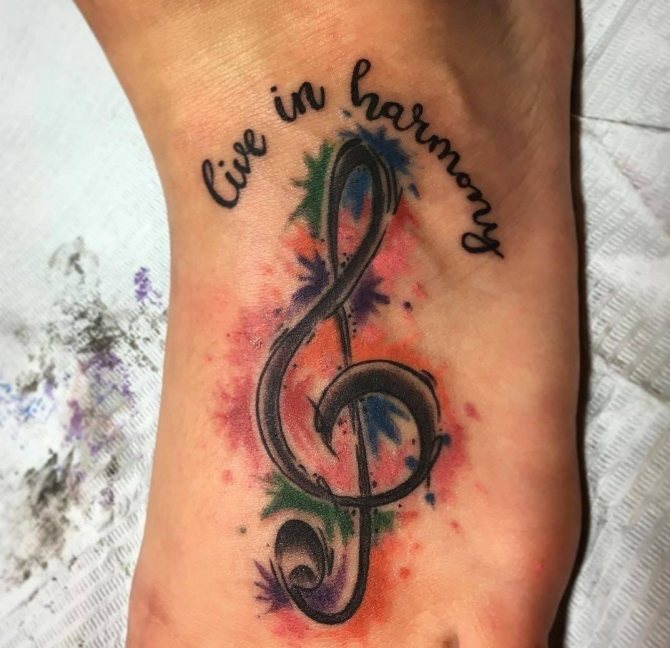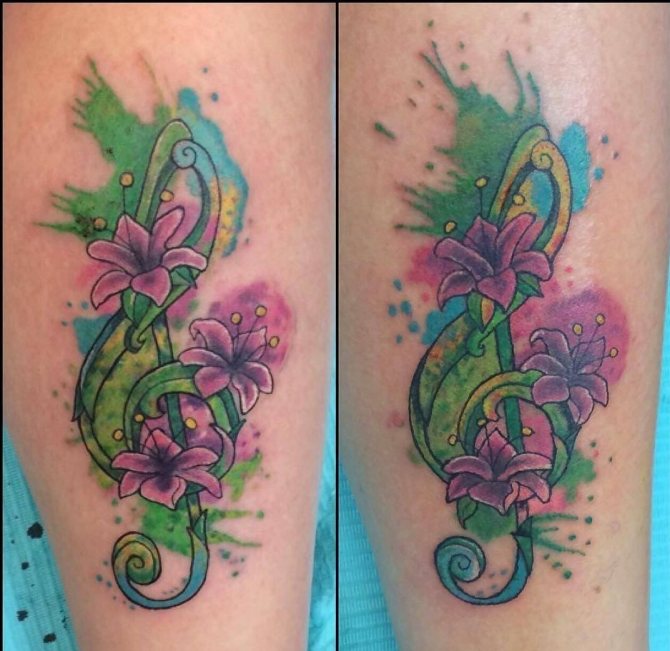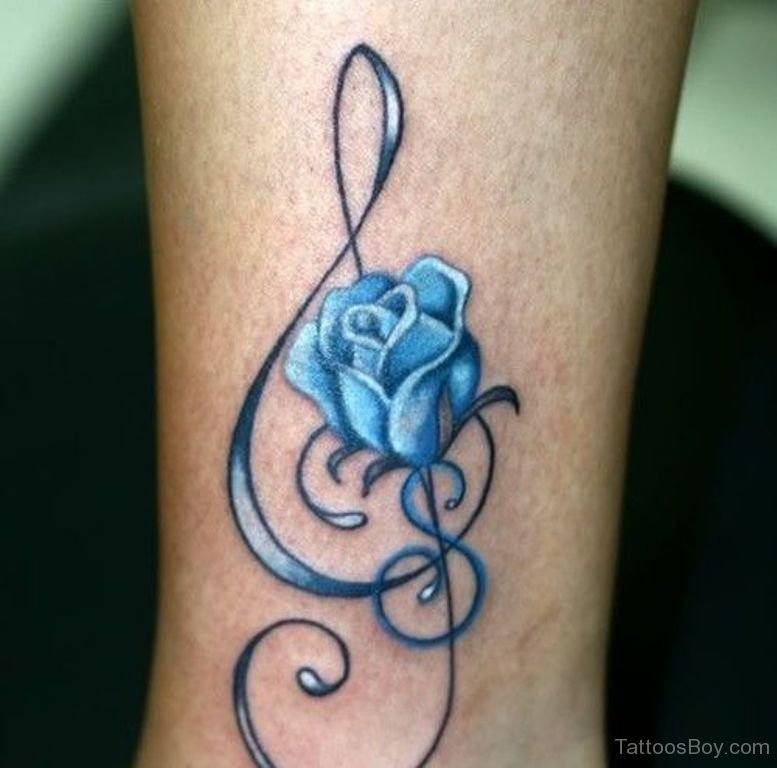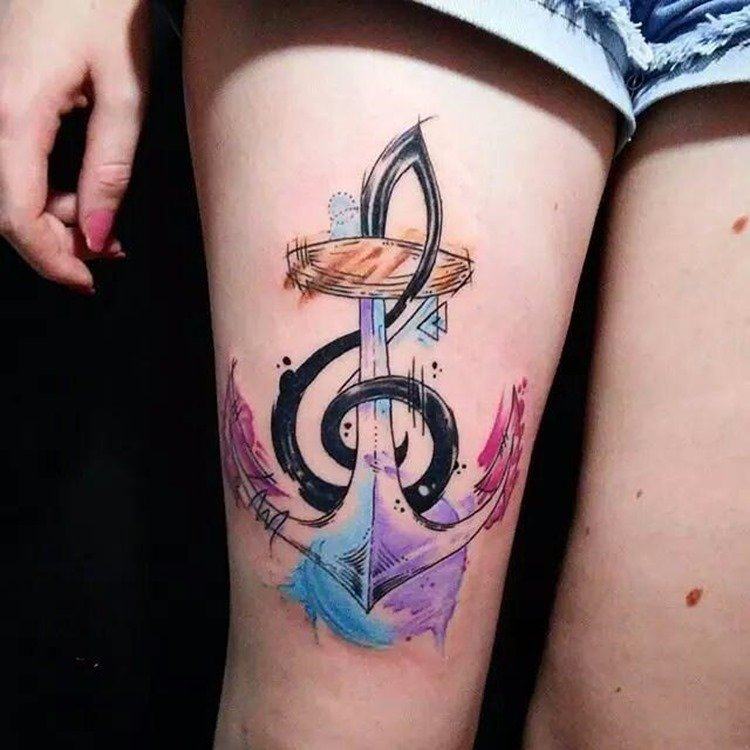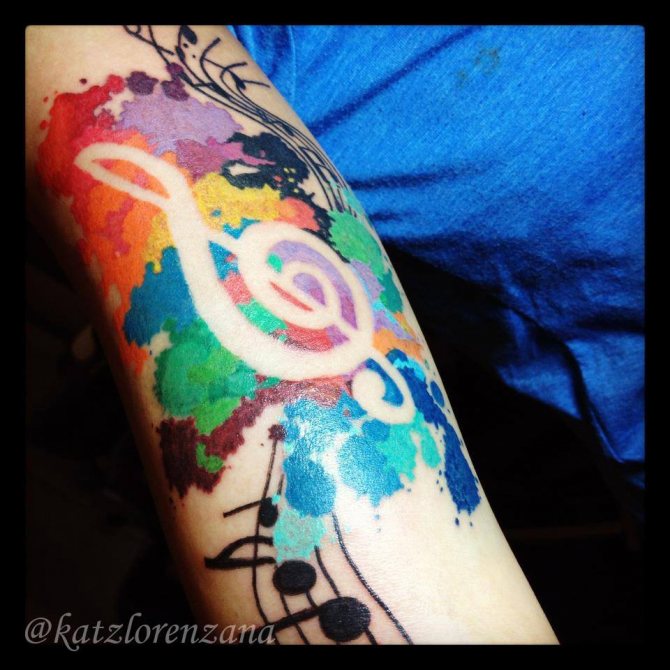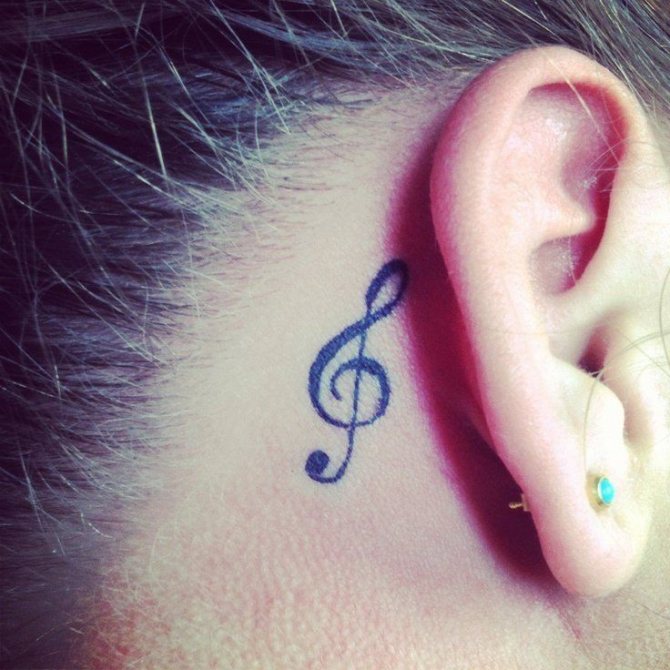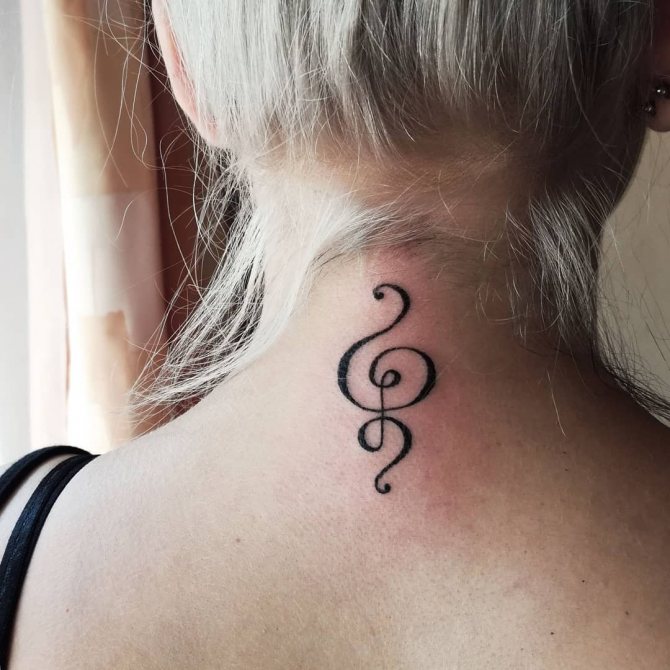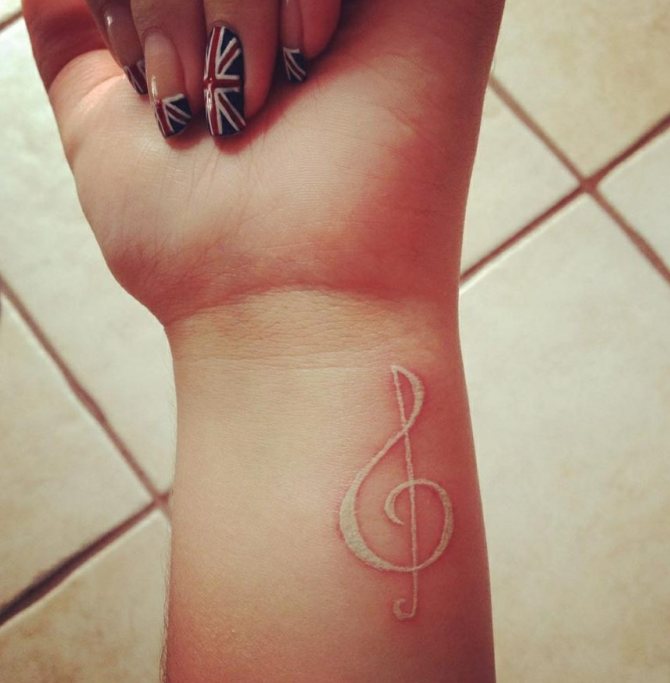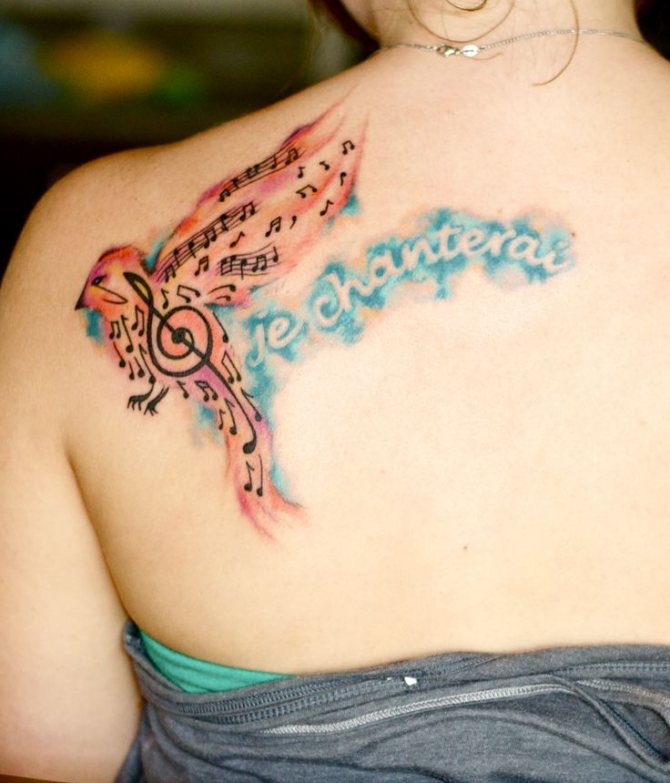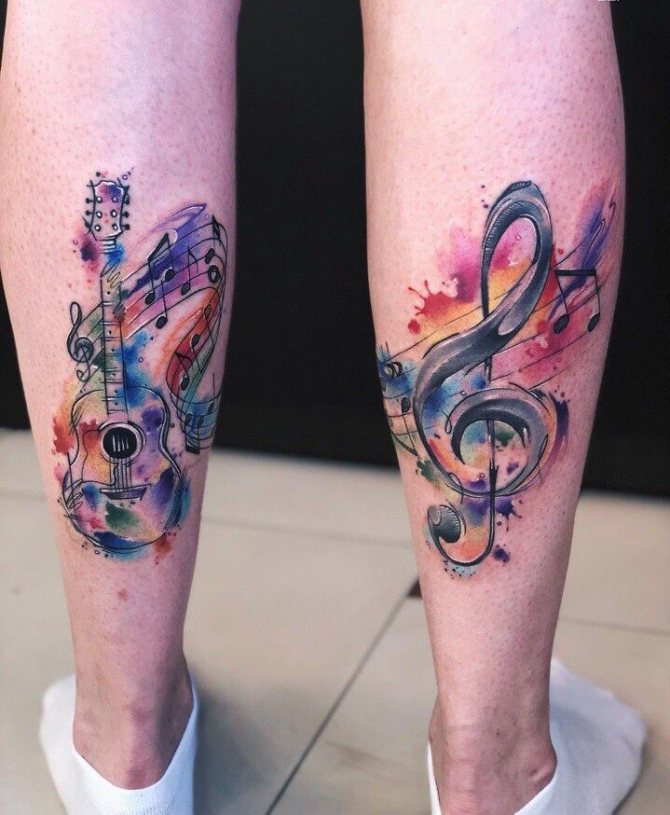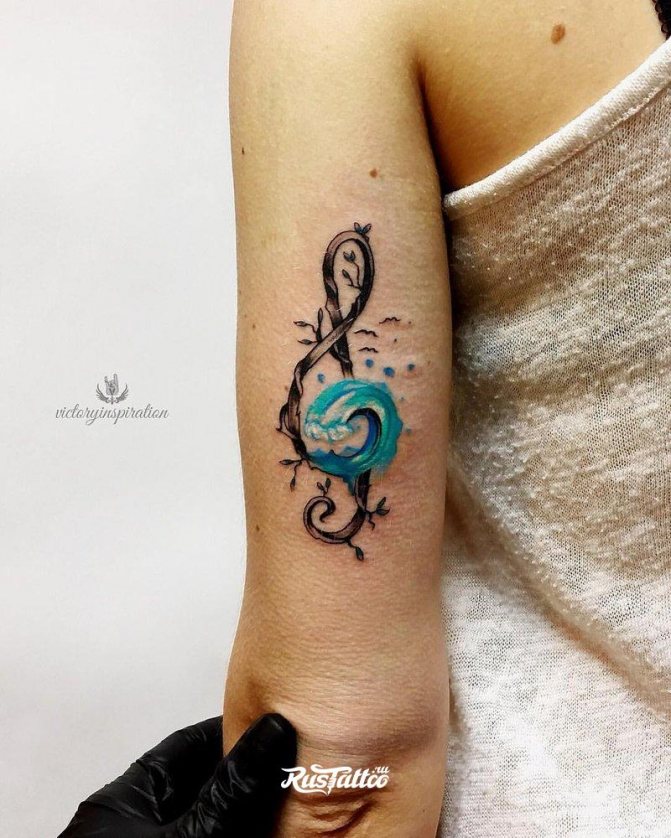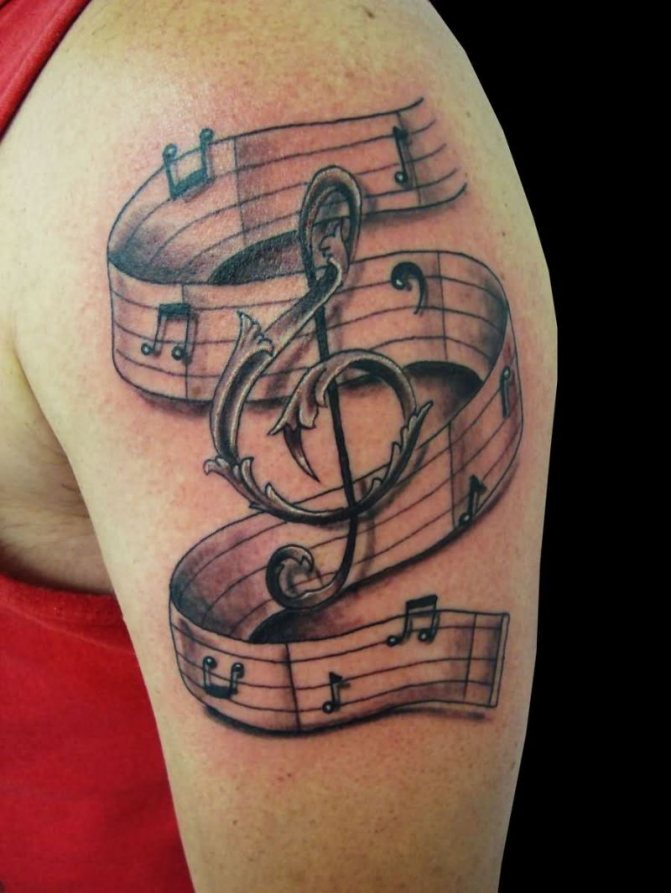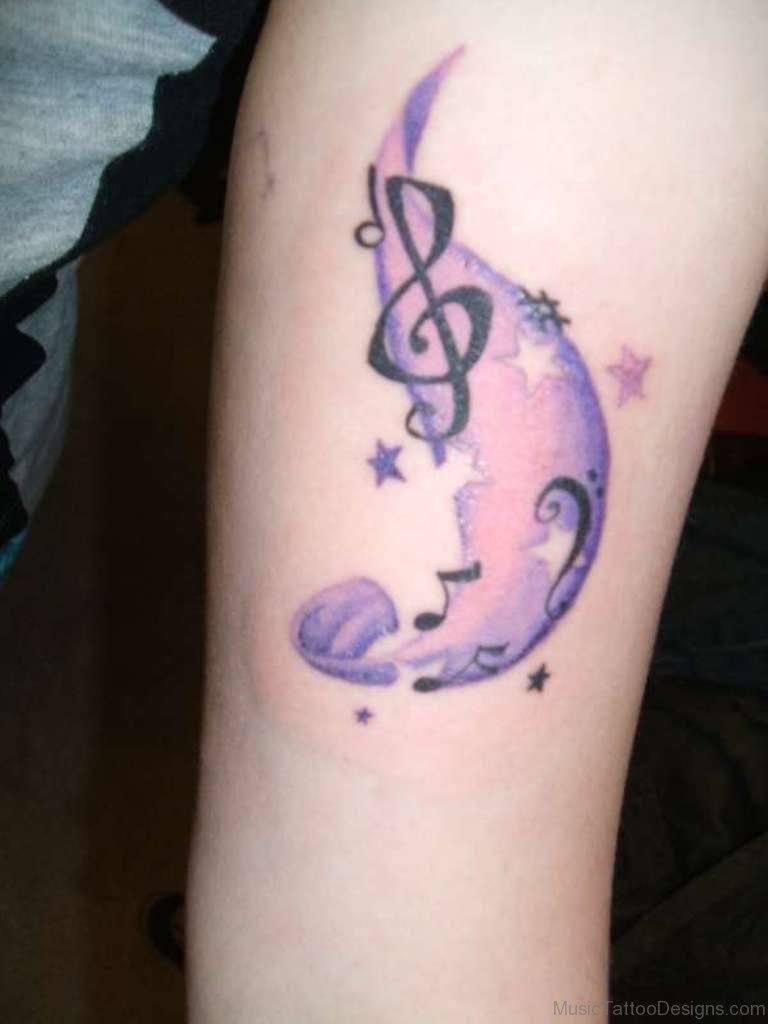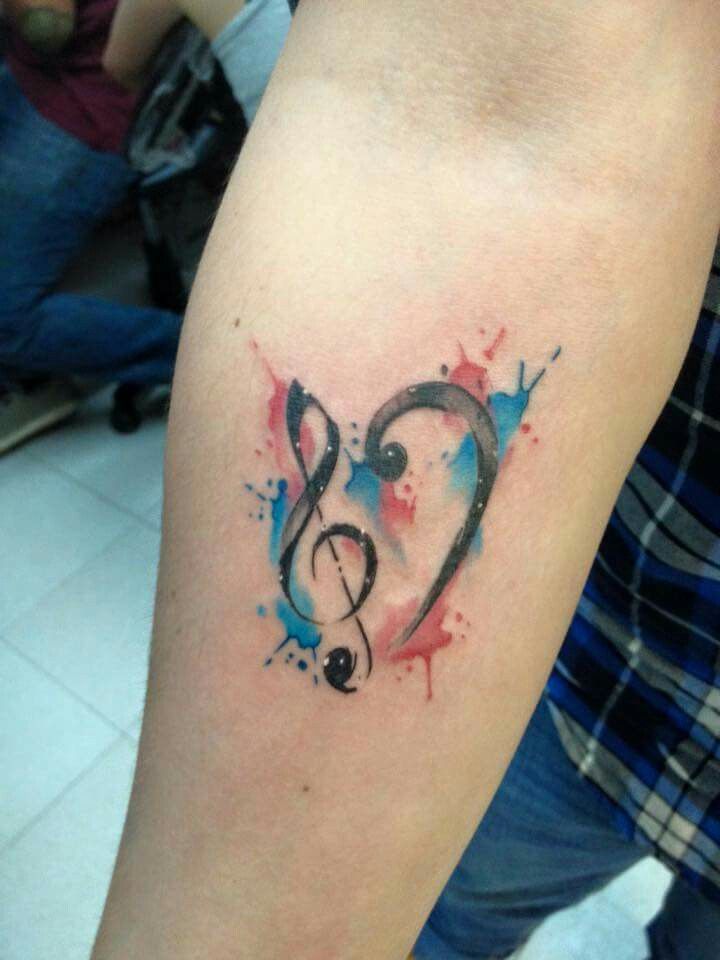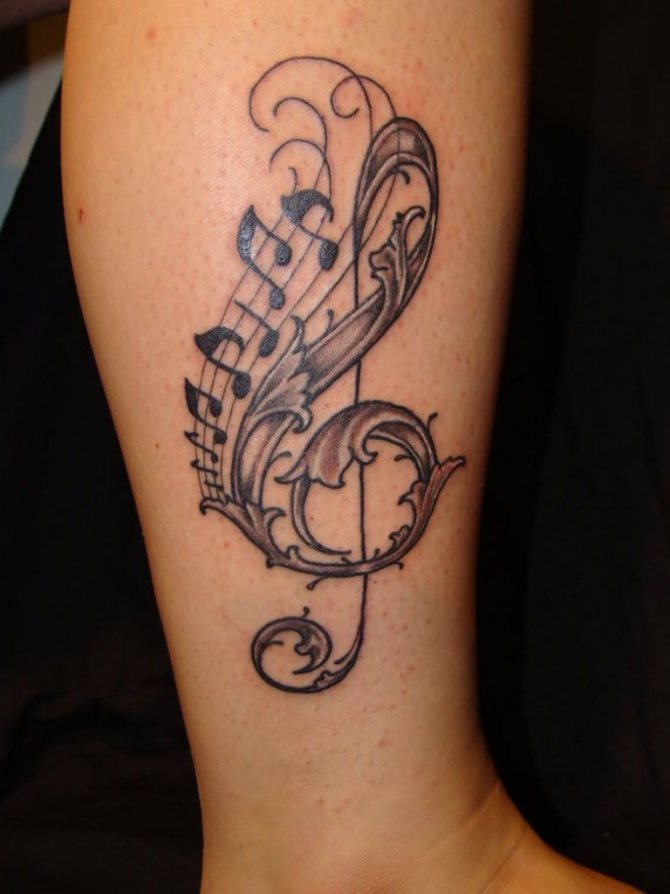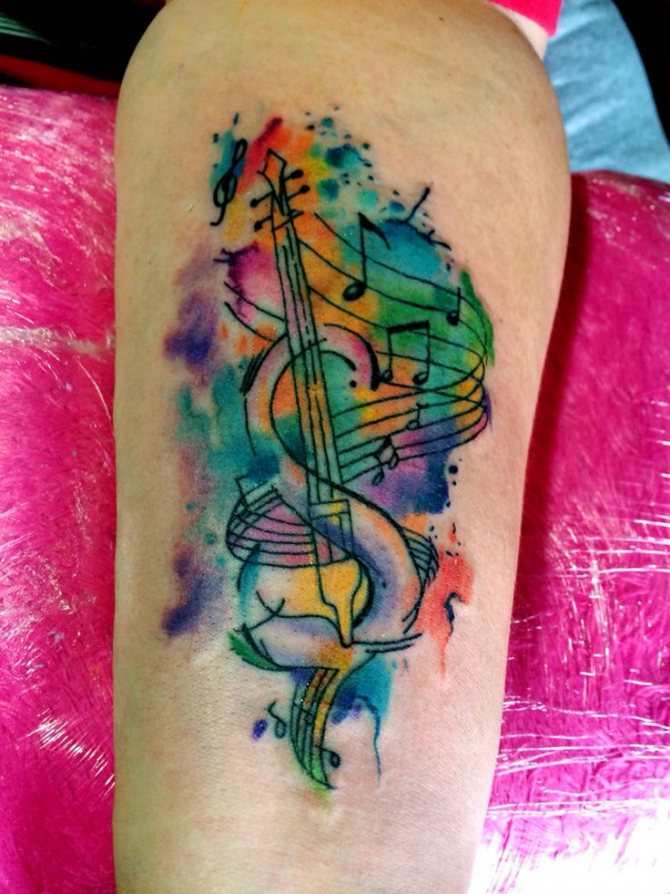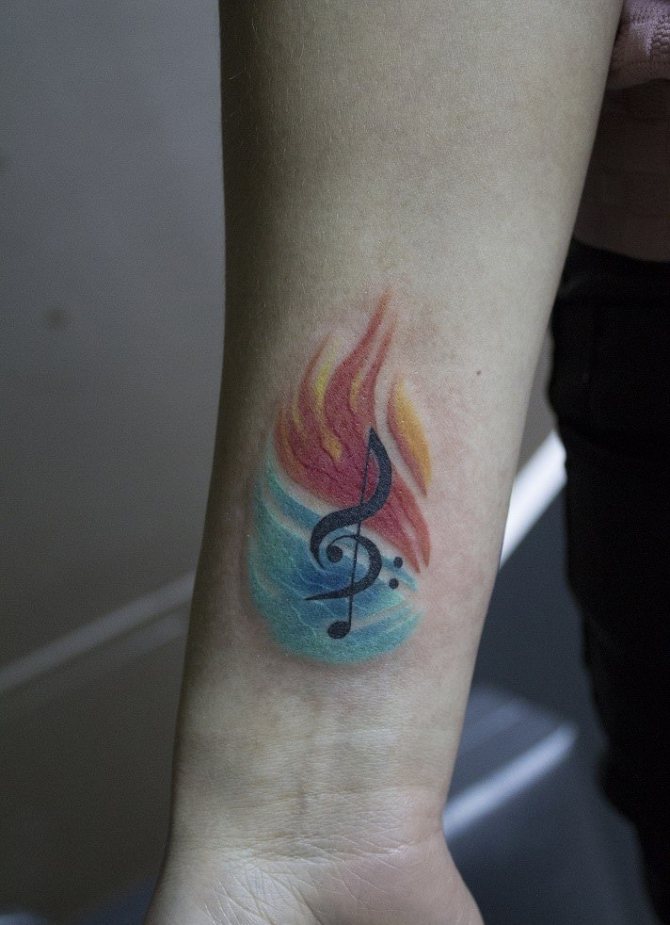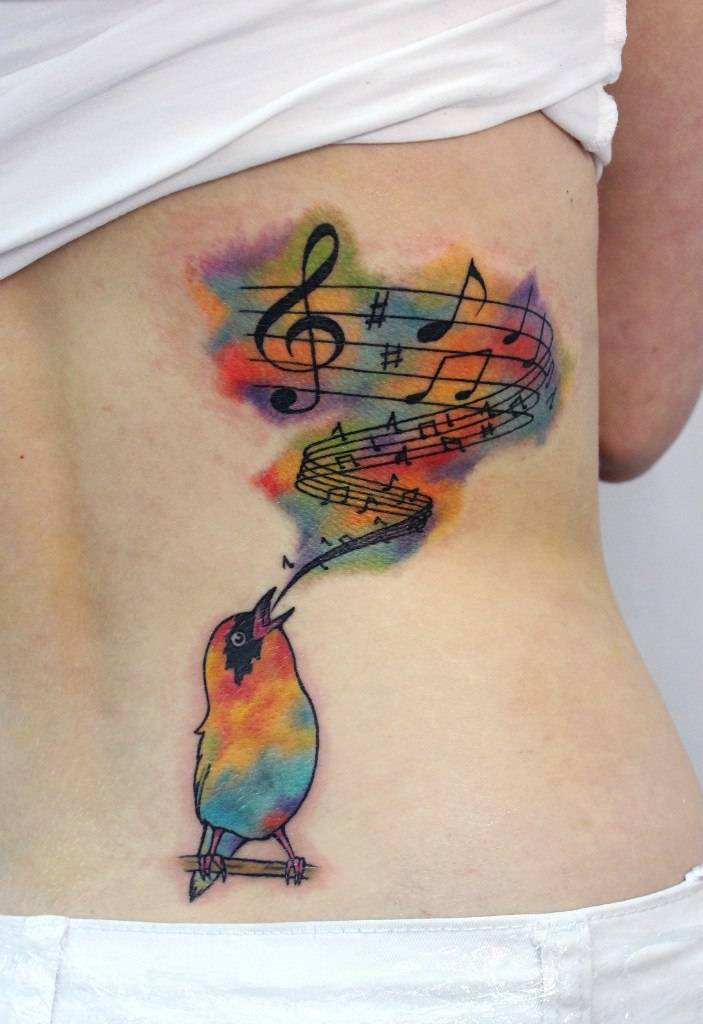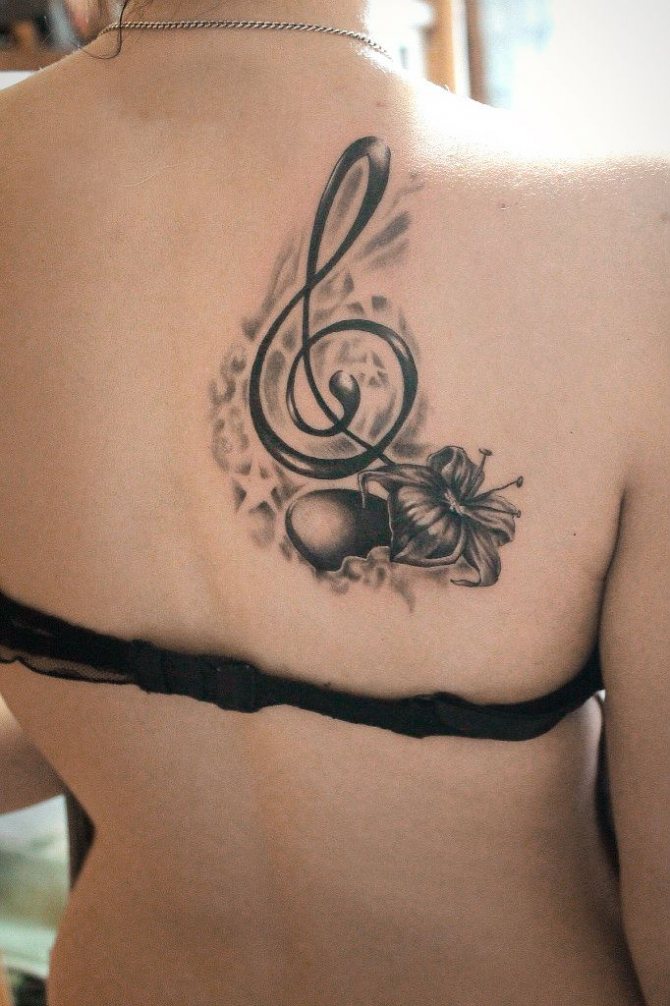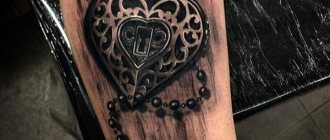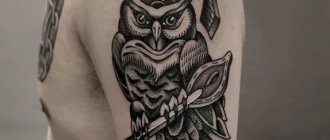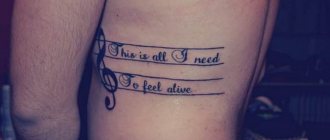The art of tattooing is one way to express your individuality. Many when choosing a tattoo sketch are based only on the external indicator of the beauty of the image, investing in it their own meaning. Today, one of the most popular body designs are images of a musical sign - the treble clef. Such a tattoo is universal and popular with both men and women. When choosing it is necessary to remember that any tattoo has a certain meaning, which is perceived by others. The treble clef in the world of tattoos appeared relatively recently, and its meaning is still being formed. But the main meaning in this image puts its owner.

History of the origin of the violin key tattoo
To describe the meaning of the tattoo of the sign of the treble clef is very difficult, because this tattoo appeared relatively recently. But all the same, the main meanings today it already has. The sign of the treble clef appeared in the early sixteenth century in Italy. And the tattoo of the treble clef for the first time appeared at the beginning of the last century. And it was the first to be applied by people associated with art or musical activity. Often the tattoo of the treble clef complemented by the image of individual notes or a full sheet of music. Also with the treble clef depicted the instrument on which the owner of the tattoo played.


Where did the names of notes come from
The current naming system came from the hymn to St. John "Ut queant laxis," which Guido used to chant in his music classes. Each successive line of this work began one step higher.
The first six notes were later named as the first syllables of each line of the hymn, the seventh was added later by analogy from the next line of the same hymn.
Ut queant laxis Resonare fibris Mira gestorum Famuli tuorum Solve polluti Labii reatum Sancte Ioannes
The first uncomfortable syllable Ut was replaced in the 17th century by the more melodic DO. There is an opinion that the name of the note came from the Latin Dominus, which means Lord.
The meaning of the treble clef in the tattoo
Today, the tattoo of the treble clef is very popular. It is applied not only to people involved in the art. Such a tattoo is used and those who are far from creativity, but respectfully refers to the music. Often the treble clef tattoo can be seen in athletes, TV stars or movie actors. The tattoo of the treble clef will tell about the light, cheerful and harmonious nature of its owner. Still, this tattoo can symbolize longing and regret for the past fun and vibrant life, carefree youth. In general, the tattoo of the treble clef symbolizes boundless love for music and is great for creative people.


Signs of alteration - sharp, flat, bacar
The musical notebook is full of different signs and some resemble hieroglyphics, and we will talk about them.
Alteration in music is a change in the basic steps of the harmony. These steps are represented by notes (Do, Re, Mi, Fa, G, La, Ti). You can change the sound of a step up or down. To indicate these changes there are special signs:
C - raises the sound of the note by half a tone.
B flat - lowers the sound of the note by half a tone.
A semitone is the distance from one key to the nearest neighboring key.


In the picture below you can see the arrangement of the consoles on the piano keyboard.


Note that the E-sharp sharp occupies the key of the note F. This is because the distance between the keys of E and F is only half a tone. As I said, the C sharp raises the note by half a tone, so it turns out that the E sharp is F. The same will be true for B-sharp, F-sharp, and C-sharp.
And this picture shows the arrangement of the B-flat:


Did you notice that the Ds and Bs occupy the same keys? So it turns out that D flat is E flat? In part, you are right - the sound of these keys is exactly the same, but you need to write them down on paper according to the rules that dictate the tonalities. Read more about tonalities in this article.
How to Write Dynes and Bels Properly
Even though we pronounce the name of the note first and then the name of the alteration sign, it is the other way around when writing it down. First the sign, then the note. Take a look:
An important place among the alteration signs is the becar.
Becar is a sign that cancels the action of both the flat and the sharp. If you see such a sign in front of a note, it means that you have to play a normal white key. That is, the note without the use of an alteration. It looks like this:
There is also a double-diz:
and a double-flat:
The first looks like a cross and raises the pitch by two semitones (that is, a whole tone). The second looks like two consecutive b-flat and lowers the pitch by two semitones. Conventionally, if the notes say f-sharp, we will play the note G on the instrument.
This may seem strange, because why go to such trouble when you could just write the note G? As it turns out, music has a lot in common with mathematics, and it too has laws that must not be broken. That's why signs like double-sharp and double-flat came into being. If you are interested in learning more about the signs of alteration, welcome to the article "Signs of Alteration."
For those who prefer to watch rather than read, I can recommend the YouTube channel of Irina Mashkovskaya, a teacher with many years of experience. Her lessons will not let you get bored, and the information is understandable even to children! Here is one of her many lessons.
Sketches of a violin key tattoo
The treble clef tattoo can be done in both simple and complex forms, in black and white images or with the addition of different colors. The intricate and interesting shape of the sign itself looks attractive. The black color will give clarity to the tattoo and highlight each line of the design. When choosing a tattoo sketch for yourself, you need to determine the technique in which you wish to put the musical key on your body. The treble clef is very simple in execution, despite its complex and curved appearance. This sign by its appearance represents joy and harmony in life, the ability and desire to naturally and simply survive the most difficult situations.


Additional musical signs
In this article we got acquainted with musical notation and the basic signs of musical notation. Nevertheless, there are many signs that we have not touched, and they are of no less value. There is a group of signs that are responsible for melismas, decorations in music; there are also signs that help simplify the writing and reading of notes. There are a host of others, but I will cite just a few:


Conclusion
Music notation includes many different signs, terms, and symbols. We got acquainted with the main ones, and if you want to know more - follow the links and learn a lot, because the world of music is so interesting.
I hope this article was helpful and now you know a lot more about what musical notation is and what role it plays for the piano. If you still have questions, post in the comments, let's figure it all out together. Don't forget to join the group vkontakte and subscribe to my youtube channel. See you soon!
Tattoo treble clef for girls
Girls are very fond of tattoos depicting different variations of the treble clef. But often use its display as part of a striking composition. Beautiful and attractive looks violin key tattoo, supplemented with the image of birds, animals, flowers, wings, butterflies, hearts, stars or various inscriptions. Tattoo with such additions symbolizes the subtlety of the female soul, lightness, awe, airiness and romance of its owner. But still tattoo treble clef is mainly applied to girls who are directly related to music. Often women choose such a tattoo in color with bright, eye-catching colors, the original technique and style of execution.
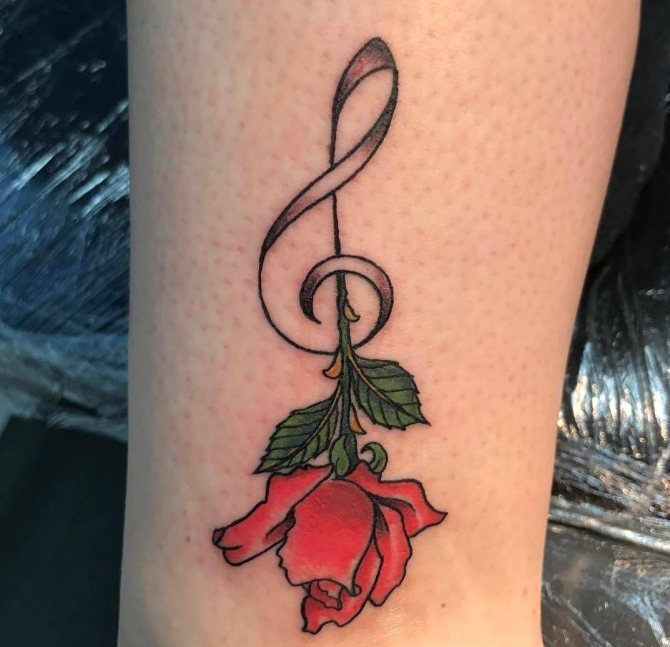

Dynamics
Musical language, like human speech, is very emotional. It has many different shades, which in music is achieved through dynamics and strokes. In Greek, "dynamis" means force. It turns out that dynamism in music is the power of sound. Special Italian terms are used to refer to the power of sound. In the table below, you can see the designations of the main dynamic tones with a deciphering.


When composing music, the composer indicates the dynamic tones of a particular fragment. Thus, in one composition, the dynamics can change several times.
Treble clef tattoo for men
Men who have chosen for themselves a tattoo of a treble clef, surely have a direct relation to music. The representatives of the stronger sex mainly choose sketches without various additions, the exception may be the image of the instrument. As for the color scheme, the men more prefer the tattoo of the treble clef, made in black in a simple and concise style. But also beautiful and manly will look on the male body tattoo treble clef, made in watercolor style, with small but bright additions in the form of a star, notes or an unusual original ornament.


Why only 7 notes


Originally, the number of notes corresponded to the number of lines in the hymn. Later it was noticed that between some notes one could place intermediate notes. They didn't change the established system, only introduced the diese-flat notes.
That's how we got the 12 notes that allow us to play every melody in every key.
INTERESTING FACT: Mozart began learning music at age 3. He attended his older sister's lessons and tried to pick up sounds on musical instruments on his own. At the age of 4, his father began to learn small pieces on the harpsichord with him, and by the age of 5, Wolfgang himself began to compose musical works.
Mini violin key tattoo
Both men and women are very popular with the miniature tattoo of the treble clef. They try to place such a miniature image on the finger, behind the ear or on the neck. Attractive will look miniature image of stanza with notes and treble clef on the wrist or ankle. In this case, the image can be made in the form of an original bracelet.


Choosing a place on the body for a tattoo
Choosing the location of the tattoo on the body, it is necessary to decide on the size of the image, as well as the willingness to show the tattoo to others. For girls, a violin key tattoo looks wonderful and attractive on the cervical curve, arm, waist or ankle. Men mostly prefer voluminous options, so they tattoo a treble clef on the shoulder, forearm, neck, back or chest.


Watercolor style for the violin key tattoo
Violin key tattoo in watercolor style is most often used by the representative of the fair sex. Having supplemented such a drawing with various additions, and having executed it in a color blurred solution, the tattoo looks really attractive. The blurriness of the drawing, as if the tattoo is applied with watercolor paints, is sure to attract attention. The most important thing is not to overdo the additions. The treble clef itself is a complex pattern, so complement it with small patterns.


Surely everyone has tried to depict the treble clef symbol with one move of the hand. And this once again shows that there is nothing complicated in the depiction of this sign, but it looks very fascinating. Not for nothing this tattoo is very popular today. Girls with this image are trying to emphasize their tenderness and sexuality, and the stronger sex - masculinity and originality. In any case, choosing a tattoo, be sure to think through all the details of the sketch and address only to the professional tattoo master.
What does musical size and beat mean?
Every piece of music has a measure. But what is it? To figure it out, we'll have to familiarize ourselves with the concept of pulse, beat, and meter.
You've probably been to concerts where the audience starts applauding as the artist performs. At first, the clapping may sound at odds, but after a few seconds it still begins to sound simultaneous. People feel the pulsation, so they clap their hands evenly and synchronously. The uniformity that characterizes musical movement is the PULSE.
The pulse has its own unit of measurement, and it is called a DALE. The lobes are even, but not equal in strength. There are strong lobes and weak lobes. The first lobe is always strong and is shown in red in the picture. The weak lobes are shown in blue.
The order of the strong and weak lobes creates the METR of the piece. In this example, we see three lobes, but that is only one possibility.
The distance from one strong lobe, to the next strong lobe, is called a TACT. In writing, the measures are divided by the beat lines.
Now we know what a meter, a beat, and a measure are, we can talk about size.
The size of the work looks like a math fraction, but without the separating line. Here are some examples:
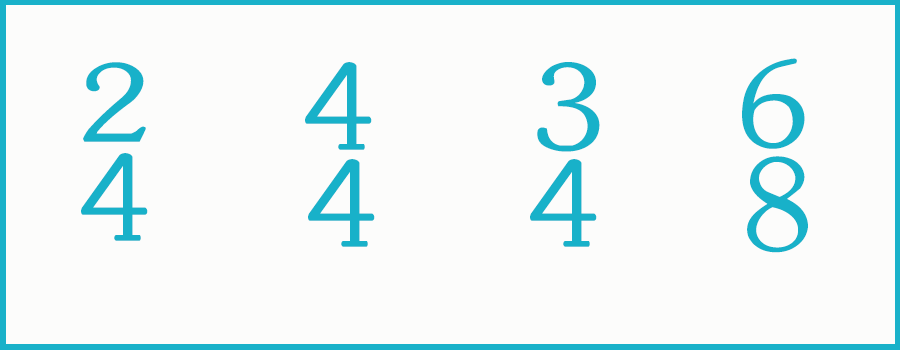

The top number tells you how many beats one measure contains.
The lower number indicates the duration of each beat.
The number at the top tells how many beats to count in each measure (2, 4, 3, 6, etc.).
The number at the bottom indicates the durations (quarters, octaves, etc.) for each beat.
Despite the fact that the fractions are uniform, the bars can be filled with notes of different lengths. Thus, octaves, sixteenths, quarters, and other durations can be combined in one measure.
Measures can be simple and complex, but you can learn more about this in the article "Music Size."
